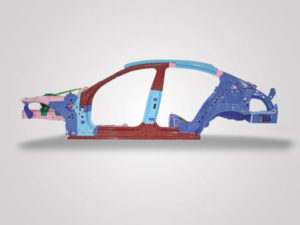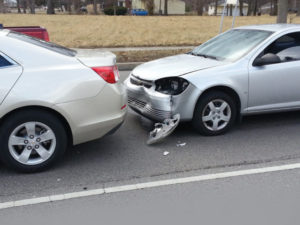High impact: How technology is raising repair costs
New technology is driving collision repair costs upwards. Dave Moss finds out why and what can be done to stop the trend.
Even as increasing fitment of new technology such as Advanced Driver Assistance systems (ADAS) is working to reduce collisions involving newer cars, the cost of repairing bodywork damage is rising. Insurers are usually amongst the first affected by such increases, so motor premiums naturally follow. But typical end of lease repairs and other bodywork completed without an insurance claim will also soon cost more. Thomas Hudd, Repair Technology Centre operations manager at the UK’s Thatcham insurance research centre sees several key reasons: “The reparability of parts such as headlamps, the increasing complexity of vehicle materials and technology, and the rising cost of spare parts, sometimes influenced by currency fluctuations, have all contributed toward significant rises in average repair bills,” he says.
Technology itself must take some blame; the centre’s research suggests average repair costs can increase greatly when ADAS technologies such as Autonomous Emergency Braking are fitted. Though every market is different, Thatcham believes ADAS fitment could increase UK pricing for a Ford Focus windscreen replacement by 123%, and for a VW Golf by 78%. Hudd explains: “We welcome ADAS and the continued growth in its fitment, but the identification and calibration of its features makes repair processes much more complex.”
OEM responsibilities
Robert McDonald, secretary general of RCAR, an association of insurance research centres operating on five continents, feels manufacturers have some responsibility for increased repair costs involving such technology. “Car makers sometimes fail to consider replacement cost, damageability or repairability in the design, and the recalibration of sensors after a repair,” he says. Hudd agrees: “This is a key focus for us – the only way forward is to collaborate and work in partnership with vehicle manufacturers, as requirements shift from one carmaker to another, and no single piece of necessary equipment covers the market. This means bodyshops must invest in expensive, highly specialised equipment – and with rapidly changing technology, who knows how long its life will be.”
McDonald points out that ADAS is only one driver of fast rising vehicle repair costs around the world. “Headlamps are a good example of how technology influences parts prices,” he states. “In the not too distant past, the average halogen headlamp for popular cars could be bought for US$200 – $400. Today, headlamps can be Bi-Xenon, include daytime running lamps, or have LED or even computer driven Laser elements for cornering or automated dimming. It’s not uncommon for popular car headlamp replacement to now cost US$1,000 – $2,000 each – with many costing over $4,000.”

Car makers sometimes fail to consider replacement cost, damageability or repairability in the design
Hybrid and electric education
With battery-electric and hybrid car sales growing around the world – a trend likely to accelerate in more sensitive markets as fleets and consumers turn away from diesel engines over pollution issues – these technologies are also currently challenging the vehicle body repair industry. “Training for technicians is still being developed, so it can keep pace with technical advances in vehicle design and construction,” says Thatcham’s Hudd. “Technicians must know how to deal with the technical architecture of high voltage and hybrid systems. This is ever more urgent – over the next 12 to 18 months they will increasingly need to recalibrate electric batteries, and repair such systems safely and effectively.”
Electric, hybrid or conventionally powered, increased use of new, more advanced materials in vehicle construction is a much less visible force driving rising costs – with its own new strings attached. “Modern cars need to be stronger for safety, and lighter for energy and emissions efficiency, demanding more sophisticated materials in their construction – such as aluminium and magnesium alloys, composites and high strength steels,” says McDonald. “These can’t be repaired as easily as materials used even in the recent past – and in some cases they can’t be repaired at all. Complexity of materials, and expense of components, will mean collision damage that was quite economical to repair just a few years ago could result in the vehicle being declared a total loss, and broken up to gather reusable parts.”
Despite international concerns over occupant injury risks bringing pressure to improve vehicle safety, in some regions new cars are still being sold with safety standards far below those of more demanding markets. Representing members researching repair techniques in 20 countries across the globe, McDonald is acutely aware of the effect on repairability where lower standards are applied to vehicle structures, safety systems and technology – often for cost saving reasons. “The impact of technology-driven increased repair costs is actually sometimes worse in markets such as Asia and South America,” he says. “Often cars in these markets have the same repair complexity requirements – if they are repaired correctly – though collision-reducing technology is often removed. I say ‘if they are repaired correctly’ because in many emerging markets, modern cars are repaired using traditional methods that are inappropriate – or simply unsafe. Cars built in these regions may also have damage-reducing bumper reinforcements removed, so they suffer more structural damage in front-to-rear collisions – a concern for both safety and repair cost.
Body of work
Dealing with all these issues – and the associated damage assessment, repair, replacement and calibration techniques, demands a widening range of skills from those involved in the work – tailored to the region where the vehicle is used. The IMI is the world’s only automotive professional association and qualifications provider, with international membership across 80 countries, which works to ensure operatives have the necessary professional expertise. Its chief executive, Steve Nash, underlines an often-forgotten link between body repair skills, quality of work, and repaired vehicle safety: “Its absolutely essential for those working on collision repairs to be well trained and properly qualified,” he says. “Consumer and businesses alike need operatives with the skills to deliver repairs to a high standard – meeting all safety regulations.”
As the body repair industry tackles rising costs, and seeks to recruit more qualified operatives to fill a long-term global shortage, another trend will raise cost and availability concerns for fleet operators. Specialisation could reduce the number of bodyshops offering a full range of major repairs on future high tech cars. “It’s inevitable that bodyshops will need to specialise in both vehicle and repair types, improve training – and invest in new equipment – if they are to survive a future with reduced repair numbers and higher repair costs,” says McDonald. “Such specialisation will drive efficiency, and help justify the purchase of equipment, and training of staff. The industry is going through the same technological advances as many others, so its inevitable that collision repair costs will continue rising. But new technology should also reduce collision numbers – hopefully at a similar or greater rate.”
Nash, meanwhile, points out the body repair industry’s heavy reliance on people. “Bodyshop repairers, technicians and painters frequently undertake the largest, most complicated repairs possible – on highly sophisticated modern cars,” he says. “Yet pay rates are often amongst the industry’s lowest – largely dictated by price constraints placed on repairers by insurance companies. Insurers and drivers must come to terms with the fact that repair costs may need to rise – so the sector can continue to recruit, train and retain suitably skilled individuals.”
Hope for the future…
Though technology is driving up car repair costs today – it could reduce fleet insurance costs tomorrow. Insurance Europe, the regional insurers association, says modern vehicles produce increasing amounts of data, which could allow insurers to develop new costing methods for motor insurance services. Development of ‘connected cars,’ as intelligent transport systems expand and vehicles incorporate more automation, could provide a useful data stream for external service providers when coupled into telematics systems delivering fleet management and vehicle tracking information.
Such linked technology could see expansion of usage-based, ‘pay-as-you-drive’ or ‘pay-how-you-drive’ insurance premiums, by monitoring driver behaviour and using specific information to accurately assess individual driver risk. This might cover factors like driving habits, vehicle condition, or geographic operating range. Risks might even be decided by the hour, bringing the possibility of daily fleet insurance premiums.
Data advancements made possible through better connected cars will have an increasing impact on motor insurance, and hopefully allow insurers to reduce premiums and claims. Subject to suitable data protection rules, examples here might include provision of driver behaviour feedback, aimed at reducing long term collision risks – and allowing insurers to progress incident claims more quickly, by accurately analysing pre-collision data.


